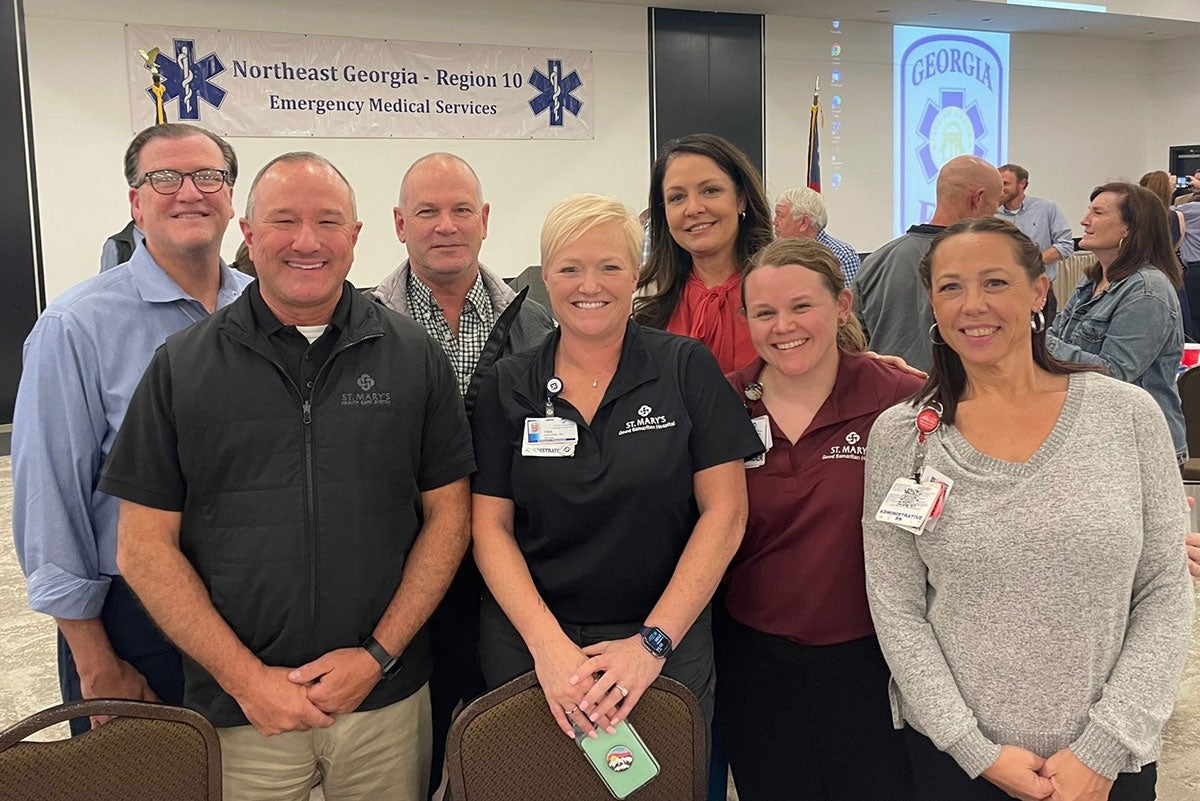EMS Week: Honoring Dedicated Professionals on the Front Lines of Care
May 24, 2023This week, May 21-27, marks the 49th annual National EMS Week. This year's theme is “Where Emergency Care Begins.” Because St. Mary’s is an organization committed to people-centered care, we invite the community to join us as we extend our appreciation for the great work these men and women do day-in and day-out in our communities.
EMS serves as the initial point of contact with many of the patients we serve – especially those in most urgent need of care – which means the EMS team plays a vital role in care delivery and patient experience. We want them to know they are valued members of our healthcare team.
Did you know?
- St. Mary's works with over 20 EMS services to provide care to more than 15 counties in the Northeast Georgia region
- St. Mary's has provided education CEUs annually to EMS providers via live classes such as stroke and cardiac care
- We will start the EMS Education Conference back up in the fall of 2023 (COVID-19 prevented us from holding this event in 2020, 2021 and 2022). This annual conference will provide education ranging from cardiology to pediatrics to EMS providers from across our region.
Also in conjunction with EMS Week, we want to recognize two statewide awards received within Georgia EMS Region 10 this year. Our 10-county region stretches north-to-south from Madison County to Greene County and west to east from Barrow County the Savannah River.
- Greene County EMS was named Georgia’s EMS Agency of the Year
- Jen Carter of Madison County EMS was named Georgia’s Paramedic of the Year
These awards could not have gone to more deserving people! Congratulations, and thank you for all you do.
I am proud that St. Mary's and Trinity Health value the important role our EMS providers play in the ever-changing healthcare delivery system. Please join me this week in thanking the men and women of EMS during EMS Week.
A brief history of EMS Week
From the American College of Emergency Physicians and the National Association of EMTs.
The modern U.S. Emergency Medical Services has a short history of a little over 49 years. It can be traced back to a single piece of legislation introduced in 1973. Sponsored by Senator Alan Cranston of California, the Emergency Medical Service (EMS) Systems Act of 1973 was a pioneering piece of legislation. It was one of the first pieces of federal legislation that sought to give all individuals equal access to emergency medical services.
The EMS Systems Act established regional EMS systems through the administration of federal grants. These grants were marked to fund the study and planning of an EMS system, establishment and initial operation, expansion and improvement, EMS training, and research. To receive the funds, regional EMS systems were required to serve everyone in their district and be run by one public or private nonprofit agency.
The EMS Systems Act also spelled out 15 elements of an EMS system. One of these was public education. In 1974, the first director of the Division of Emergency Medical Service Systems (DEMSS) – David R. Boyd – convinced President Gerald Ford to proclaim an "Emergency Medical Services Week" to help promote the goals in the legislation. The week would serve as an opportunity for EMS systems around the country to reach out to the public and help educate them on emergency medical care and more. This annual observance continued for four more years and was then reinstituted by the American College of Emergency Physicians (ACEP) in 1982.
According to the American College of Emergency Physicians, the three primary goals of EMS Week are:
-
Promote your EMS service within your local community.
-
Educate the public on safety and health-related topics.
-
Provide information on new EMS clinical procedures or equipment to EMS providers.
Around this time the observance of EMS Week was moved to September. In 1992 EMS Week was again moved to be the 3rd week in May. The move was made to separate EMS Week from Fire Prevention week in October. The rationale for the move was the majority of fire and EMS services felt having the two events back to back hurt the effectiveness of each program so EMS Week was moved to May.
Consider this…
1500 B.C. – The development of EMS has been based on tradition and, to some extent, on scientific knowledge. Its roots are deep in history. For example, the Good Samaritan bound the injured traveler’s wounds with oil and wine at the side of the road, evidence of treatment protocols that may have existed.
1732 – The first recorded use of mouth-to-mouth ventilation, involving a coal miner in Dublin.
1865 & 1869 – Civilian ambulance services in the United States began in Cincinnati and New York City, respectively. Hospital interns rode in horse drawn carriages designed specifically for transporting the sick and injured.
1922 – The first volunteer rescue squads organized in Roanoke, Va., and along the New Jersey coast. Gradually, especially during and after World War II, hospitals and physicians faded from pre-hospital practice, yielding in urban areas to centrally coordinated programs. These were often controlled by the municipal hospital or fire department, whose use of “inhalators” was met with widespread public acceptance. Sporadically, funeral home hearses, which had been the common mode of transport, were being replaced by fire department, rescue squad and private ambulances.
1969 – The first nationally recognized training course for EMTs was held in Wausau, Wis., as a test site for the new DOT curriculum. The physician coordinator, Joseph D. ‘Deke’ Farrington, was an EMS pioneer from Minocqua. Among his accomplishments, he promoted the use of extrication, invented the spine board and was responsible for the original 81-hour curriculum developed by Dunlap & Associates. He also encouraged many other physicians to become involved in EMS.




